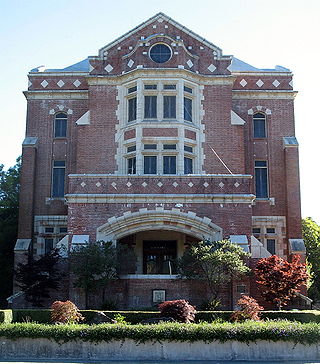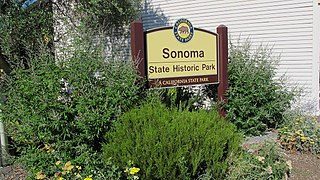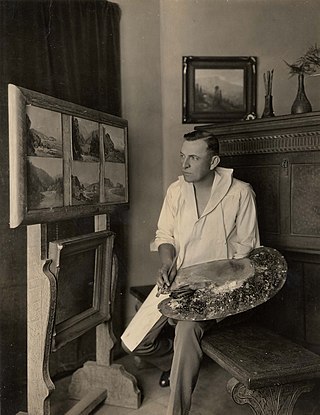
John Griffith Chaney, better known as Jack London, was an American novelist, journalist and activist. A pioneer of commercial fiction and American magazines, he was one of the first American authors to become an international celebrity and earn a large fortune from writing. He was also an innovator in the genre that would later become known as science fiction.

Glen Ellen is a census-designated place (CDP) in Sonoma Valley, Sonoma County, California, United States. The population was 784 at the 2010 census, down from 992 at the 2000 census. Glen Ellen is the location of Jack London State Historic Park, Sonoma Valley Regional Park, and a former home of Hunter S. Thompson.

Santa Rosa is a city in and the county seat of Sonoma County, in the North Bay region of the Bay Area in California. Its population as of the 2020 census was 178,127. It is the largest city in California's Wine Country and Redwood Coast. It is the fifth most populous city in the Bay Area after San Jose, San Francisco, Oakland, and Fremont; and the 25th-most populous city in California.

The Little Lady of the Big House (1915) is a novel by American writer Jack London. It was his last novel to be published during his lifetime.

Sonoma Valley is a valley located in southeastern Sonoma County, California, in the North Bay region of the San Francisco Bay Area. Known as the birthplace of the California wine industry, the valley is home to some of the earliest vineyards and wineries in the state, some of which survived the phylloxera epidemic of the 1870s and the impact of prohibition in the early 20th century. Today, the valley's wines are promoted by the U.S. federal government's Sonoma Valley and Carneros AVAs.

The John Muir National Historic Site is located in the San Francisco Bay Area, in Martinez, Contra Costa County, California. It preserves the 14-room Italianate Victorian mansion where the naturalist and writer John Muir lived, as well as a nearby 325-acre tract of native oak woodlands and grasslands historically owned by the Muir family. The main site is on the edge of town, in the shadow of State Route 4, also known as the "John Muir Parkway."

Joan London was an American writer and the older of two daughters born to Jack London and his first wife, Elizabeth "Bess" Maddern London.

Kenwood is an unincorporated community and census-designated place (CDP) in Sonoma County, California, located on Sonoma Highway between the cities of Santa Rosa and Sonoma. It lies east of Sonoma Creek in the upper part of Sonoma Valley, a region sometimes called the Valley of the Moon. Bennett Mountain lies west of the town, and Sugarloaf Ridge to the northeast. The population was 1,028 at the 2010 census.

Charmian London was an American writer and the second wife of Jack London.

Rancho Petaluma Adobe is a historic ranch house in Sonoma County, California. It was built from adobe bricks in 1836 by order of Mariano Guadalupe Vallejo. It was the largest privately owned adobe structure built in California and is the largest example of the Monterey Colonial style of architecture in the United States. A section of the former ranch has been preserved by the Petaluma Adobe State Historic Park and it is both a California Historic Landmark and a National Historic Landmark. The Rancho Petaluma Adobe State Historic Park is located on Adobe Road on the east side of the present-day town of Petaluma, California.

Sonoma Mountain is a prominent landform within the Sonoma Mountains of southern Sonoma County, California. At an elevation of 2,463 ft (751 m), Sonoma Mountain offers expansive views of the Pacific Ocean to the west and the Sonoma Valley to the east. In fact, the viticultural area extends in isolated patches up the eastern slopes of Sonoma Mountain to almost 1,700 feet (520 m) in elevation.

Jack London State Historic Park, also known as Jack London Home and Ranch, is a California State Historic Park near Glen Ellen, California, United States, situated on the eastern slope of Sonoma Mountain. It includes the ruins of a house burned a few months before Jack London and family were to move in, a cottage in which they had lived, another house built later, and the graves of Jack London and his wife. The property is both a California Historical Landmark and a National Historic Landmark.
Albert Lincoln Farr was an American residential architect, who designed homes in the Craftsman and Georgian styles.

The Sonoma Developmental Center (SDC) was a large state school in California, United States for people with developmental disabilities, and is located in Eldridge in Sonoma County. Former names for this hospital include California Home for the Care and Training of Feeble Minded Children (1883); Sonoma State Home (1909); Sonoma State Hospital (1953); and Sonoma Developmental Center starting in 1986. The center closed on 31 December 2018.

Sonoma State Historic Park is a California State Park located in the center of Sonoma, California. The park consists of six sites: the Mission San Francisco Solano, the Sonoma Barracks, the Blue Wing Inn, La Casa Grande, Lachryma Montis, and the Toscano Hotel.
Rancho Petaluma was a 66,622-acre (269.61 km2) Mexican land grant in present-day Sonoma County, California given in 1834 by Governor José Figueroa to Mariano Guadalupe Vallejo. Rancho Petaluma stretched from Petaluma River on the west over the hills and down to Sonoma Creek on the east, including all land that lay between these two waterways from the edge of San Francisco Bay to approximately the present site of Glen Ellen. The rancho included present-day Petaluma and Lakeville.
Rancho Los Guilicos was an 18,834-acre (76.22 km2) Mexican land grant in present-day Sonoma County, California given in 1837 by Governor Juan B. Alvarado to John (Juan) Wilson. The grant extended along Sonoma Creek, south of Santa Rosa from Santa Rosa Creek south to almost Glen Ellen, and encompassed present day Oakmont, Kenwood and Annadel State Park.
The Valley of the Moon Natural History Association (VMNHA) is a 501(c)(3) Non-Profit Organization based in Sonoma County, CA which cares for the Jack London, Annadel and Sugarloaf Ridge State Parks.

Netta Eames was born Ninetta Wiley, in Wisconsin on September 26, 1852. She is commonly known as Netta. She is best known as a writer and magazine editor in the late 1800s and early 1900s. As the editor of the San Francisco based Overland Monthly magazine, she became an early proponent of Jack London as a writer. She wrote the 1900 biography.|group=Note}} and a promotional biography of London in Overland Monthly in 1900, which helped to establish his career. Later she was his business manager and neighbor.

Tilden Daken was an American landscape painter known primarily for his oil paintings of the California redwoods, the Sierra Nevada mountains, and the countryside scenery of Northern California and Southern California. He also painted in Alaska, Mexico, Baja, the Hawaiian Islands, the South Seas, and parts of the East Coast of the United States.


















